Bose vs. Sony Headphones: A Face-Off Between Today's Best Audio Accessories
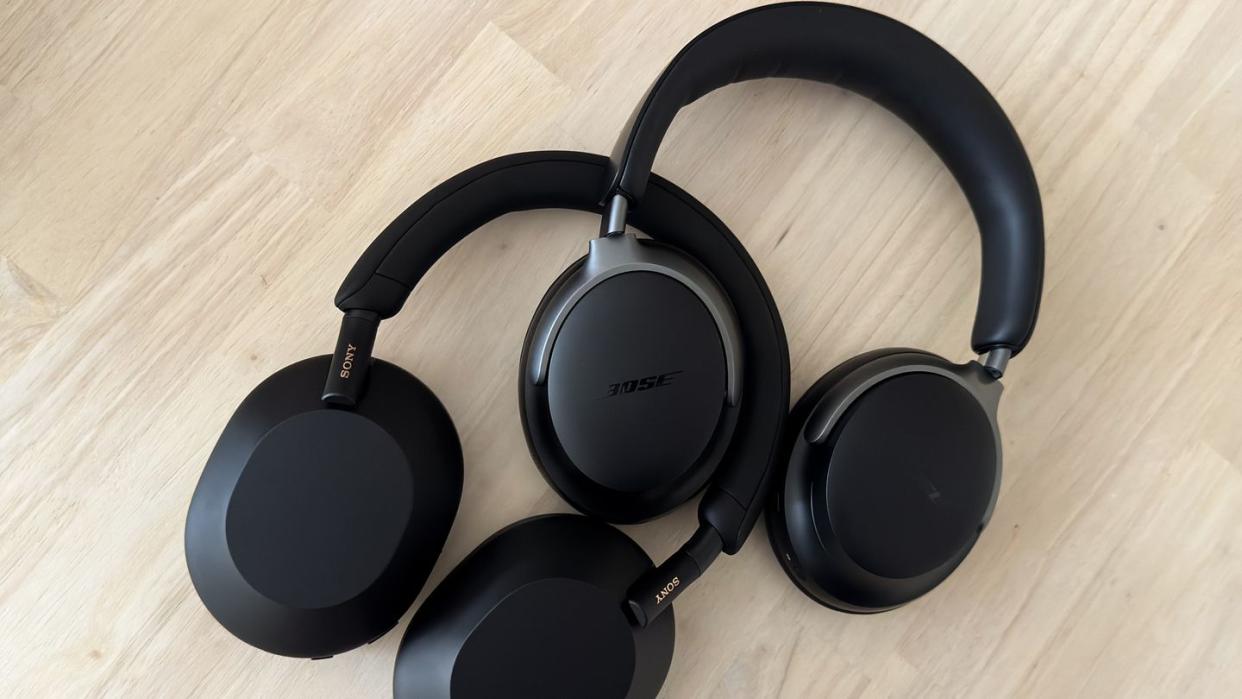
"Hearst Magazines and Yahoo may earn commission or revenue on some items through these links."
The noise-canceling headphones by Bose and Sony have rightfully been dubbed as some of the best wireless earbuds on the market. Following years of developing aviation headsets, Bose introduced the QuietComfort headphones in 2000. Sony — a longtime giant in the consumer audio space — launched the MDR-NC500D noise-canceling headphones in 2008, long after releasing the MDR-5700 for airline passengers in the early 1990s.
Fast-forward a couple of decades to today, and you'll find the latest Bose and Sony noise-canceling headphones at the top of a product category that's now brimming with options and different model types, such as wireless earbuds for working out or open-ear headphones constructed for safety. But, many have wondered if there was a battle between Bose vs. Sony headphones, which would come out on top?
Bose has the QuietComfort Ultra wireless headphones as the flagship of its range, while Sony's WH-1000XM5 cans are its best yet. Both over-ear headsets offer elegant design, impeccable comfort, and amazing audio quality at an identical price point — they each cost around $400.
Bose and Sony Headphones Comparison
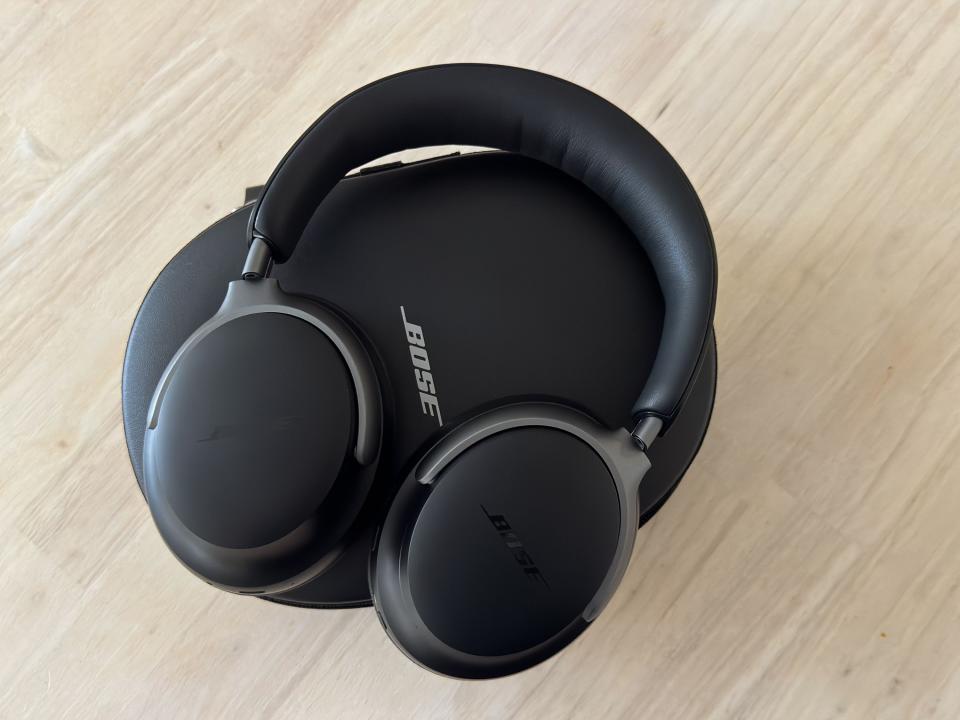
QuietComfort Ultra Wireless Headphones
amazon.com
$429.00
Stefan Vazharov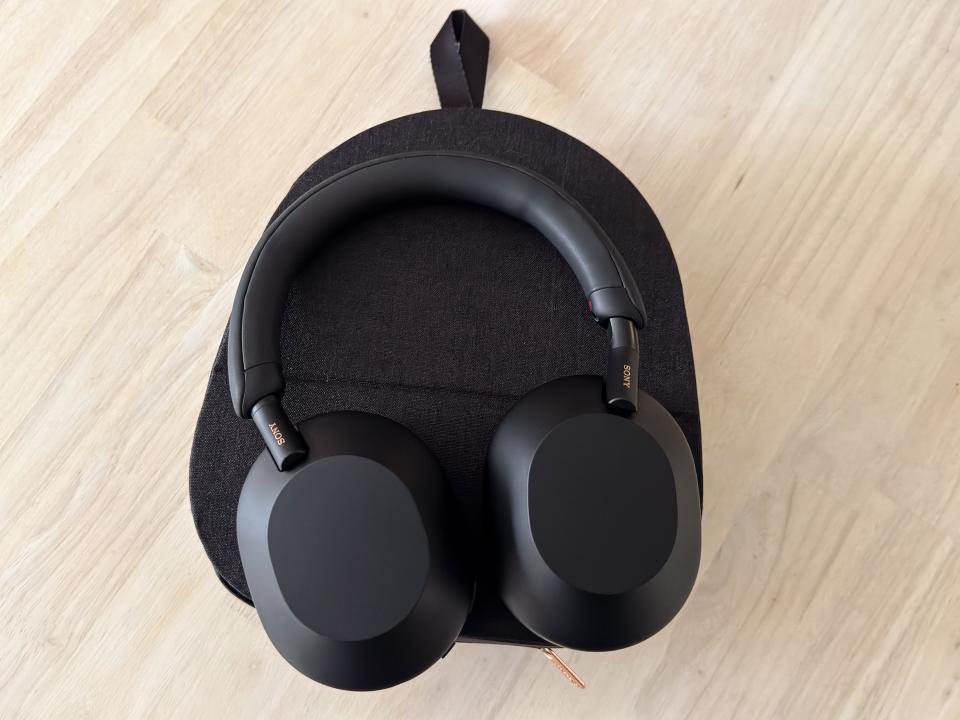
WH-1000XM5 Headphones
amazon.com
$398.00
Stefan VazharovGiven their makers' history of making amazing audio products and their identical pricing, choosing between the battle of Bose vs. Sony headphones, specifically Sony WH-1000XM5 and the Bose QuietComfort Ultra, is hard-fought. If you're looking to buy a pair for yourself or as a reflective tech gift to someone in your life, there are a few questions to first ask yourself.
Do you or the giftee prioritize stereo sound, or is spatial audio reproduction a must-have? Is battery life a major difference maker?
To help you choose, I spent months analyzing the Bose vs. Sony headphones test, meticulously nitpicking each design, ergonomics, audio performance, and battery life. Here's everything you need to know about these excellent products.
Design and Ergonomics
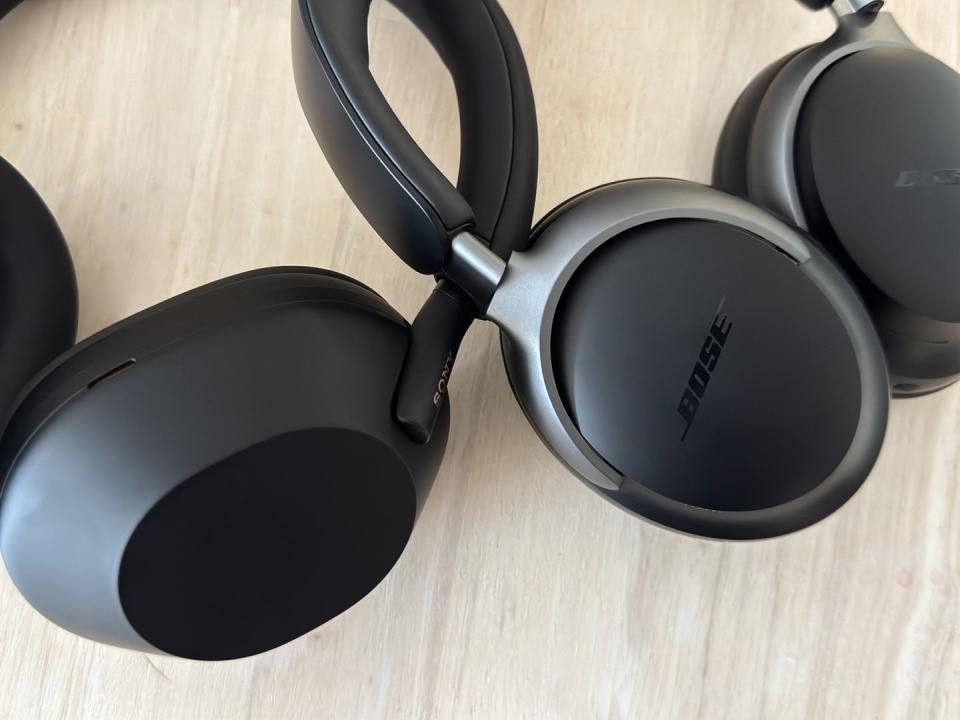
→ Design
The QuietComfort Ultra and the WH-1000XM5 headphones have a pleasantly understated yet undeniably upmarket design. Bose's looks are a fusion of the high-tech Bose Headphones 700 and the instantly recognizable QuietComfort line.
Sony's WH-1000XM5 cans brought a welcome refresh to the storied WH-1000X lineup. Their thinner headband gave them a different and fresher silhouette than the iterative older iterations.
If it were a Bose vs. Sony headphones test on looks alone, I'd give the Bose QuietComfort Ultra a slight edge in design. The aluminum bits that connect the headphones' ear cups to the headband give them a slightly more premium look and, because they are frequent points of contact, nicer tactility.
→ Ergonomics and Controls
Things are even on the ergonomic front — both the QuietComfort Ultra and the WH-1000XM5 headphones are exceptionally comfortable. I have spent entire workdays and long flights with them on, without feeling discomfort or fatigue. Both sets impressed me with cushy earpads and headbands that don't clamp the head with enough force to cause weariness.
The control layout of the Bose and Sony headphones is different, and choosing one over the other depends on your or the giftee's personal preferences. I prefer the QuietComfort Ultra's clicky button and dedicated volume strip over Sony's touch controls. The latter include swiping gestures for changing tracks and controlling the volume and a double tap to pause audio playback.
The WH-1000XM5 touch setup has a learning curve, but it didn't take me long to master it. There's an option to disable the touch controls to avoid accidental inputs (e.g., while adjusting the headphones). Thankfully, both headsets have hardware buttons for noise cancellation and device pairing, ensuring that these core features are easy to control.
I tip my hat to Sony for making ambient sound awareness as easy to activate as placing your palm on the right ear cup. Making the gesture silenced the playback and made me hear everything around me in an instant. In the case of the Bose QuietComfort Ultra, I had to reach for the button to change from noise cancellation to aware mode.
Speak-to-chat is another nifty way to enable ambient sound awareness on Sony WH-1000XM5. The feature detects your voice, and its convenience is game-changing for interacting with co-workers in an open office space.
That said, in the Bose vs. Sony headphones ergonomics and controls test, it's a tie.
Audio Performance
→ Sound
Juxtaposing the sound quality for the Bose vs. Sony headphones battle is the equivalent of pitting stereo brilliance against spatial audio excellence. Each product has an edge over its rival in one department, leaving the Bose vs. Sony headphones decision to the consumer's personal preferences.
After comparing the out-of-the-box stereo production of both headsets (before making any equalizer customizations), I'd give the WH-1000XM5 a wafer-thin edge over its Bose rival. Sony's headphones delivered a crisp and vibrant sound while streaming from Tidal to an Android device over Bluetooth. Sony's headphones use the LDAC wireless codec, an industry-wide standard for high-grade wireless sound.
The Sony Headphones companion app has a more extensive set of tools for customizing sound to your exact preference. The noteworthy highlights include a graphic equalizer and a slider for adjusting the bass intensity.
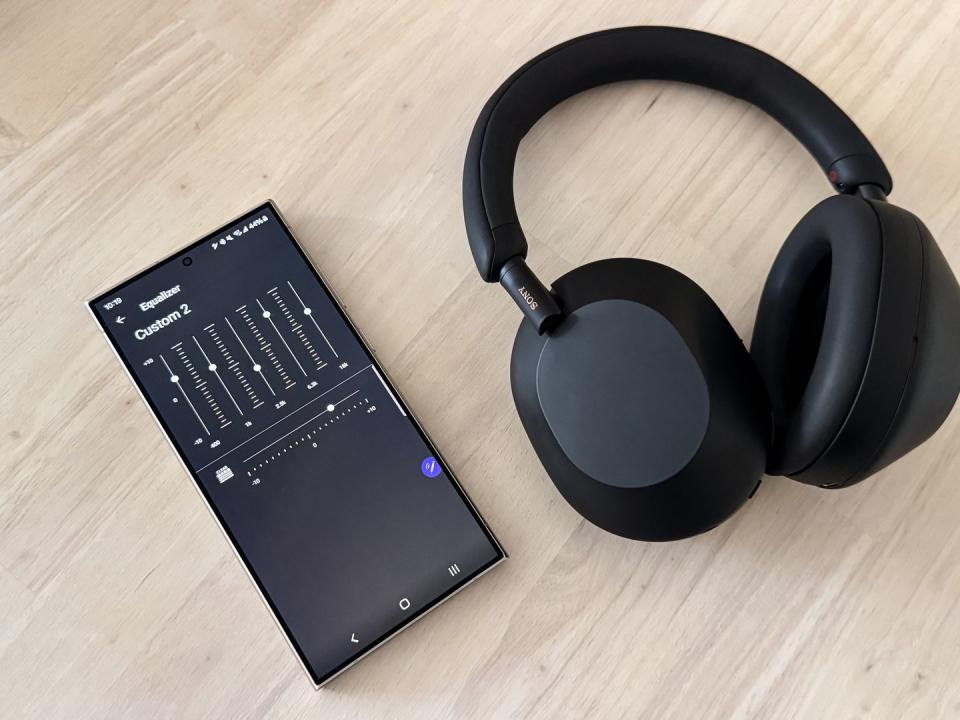
Thanks to support for Qualcomm Snapdragon sound, the Bose QuietComfort Ultra headphones can also output lossless sound with fantastic quality when linked to an Android phone. Still, the Bose Music app has more basic, less granular sound customization tools and no option to save custom presets for quick access.
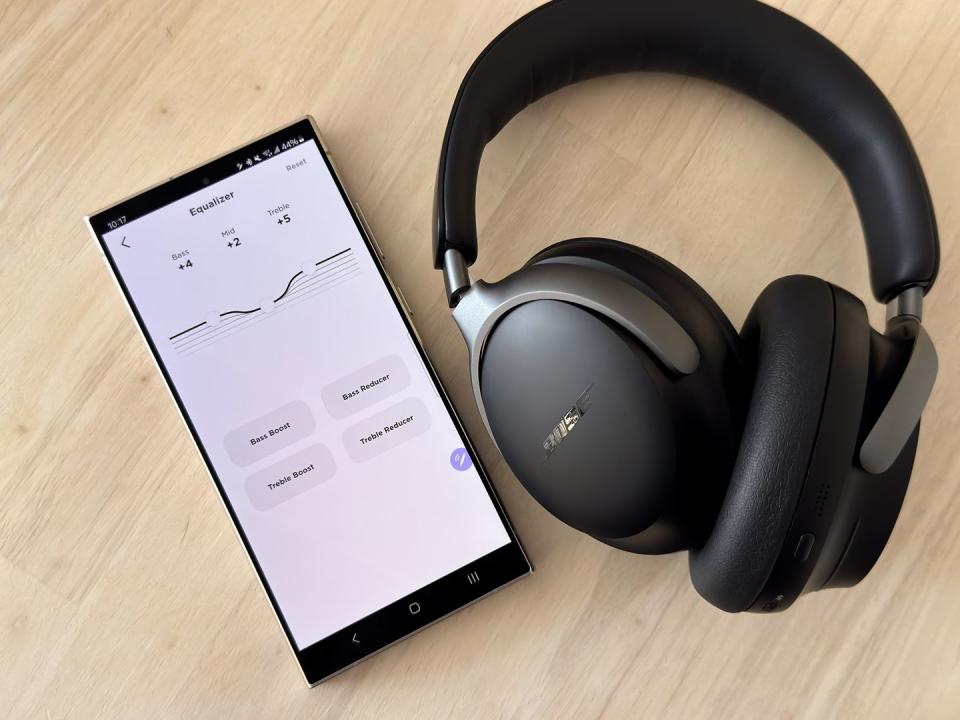
Both headsets have excellent call quality. Befitting their price tags, the Bose QuietComfort Ultra and the Sony WH-1000XM5 can also simultaneously connect to two devices for easy switching.
→ Spatial Audio
When it comes to spatial audio — a buzz-worthy and futureproof surround sound feature of today's finest wireless headphones, earbuds, and speakers — the Bose QuietComfort Ultra has a significant advantage over the Sony WH-1000XM5. Featuring proprietary tech dubbed Bose Immersive Audio, the QuietComfort Ultra treated me to captivating multi-dimensional sound that was always available with the press of a button.
My favorite thing about Bose Immersive Audio is that it works with any audio content, not just Dolby Atmos-enhanced media. The functionality has two settings — motion and still — with the last one bringing a lifelike experience with dynamic head tracking. Bose pulled off an impressive feat for democratizing spatial audio via its tech.
The Sony WH-1000XM5 headphones can also deliver multi-dimensional sound, courtesy of the audio maker's 360 Reality Audio format. It brings an immersive acoustic experience when you play enhanced content from streaming services that offer it.
However, the 360 Reality Audio setup process for iPhone and Android is more cumbersome (you need to take photos of your ears via the Sony Headphones app), and the selection of enhanced tracks is more limited — Amazon Music and Tidal are the only big-name streaming services to offer them.
So, if it's a Bose vs. Sony headphones spatial audio fight, Bose handedly wins.
→ Noise Cancellation
Both the Bose QuietComfort Ultra and the Sony WH-1000XM5 headphones are capable of delivering world-class noise cancellation. Activating the feature on each headset is like pressing a mute button for your surroundings. The products' performance in this department alone is a solid reason to spend big to snag one.
The Bose QuietComfort Ultra headphones give the user a ton of options to customize the noise-canceling experience in the app. You or the giftee can toggle between various, including custom ones, by long-pressing the cans' multi-function button. Creating custom modes presents you with a whopping ten levels of noise cancellation, the option to select (or not) an immersive audio setting, and even activate a wind block feature for outdoor use.
For comparison, the Sony WH-1000XM5 has an adaptive sound control feature that toggles between noise cancellation and ambient sound based on your actions or location. You can adjust the ambient sound control intensity via a slide and even activate a voice passthrough feature for filtering in speech without disabling noise cancellation. This is convenient if you or the recipient are frequently on the move, but it needs permission to use your location via the Sony Headphones app.
Given that the noise cancellation performance of the Bose and Sony headphones is on par, in this round of the Bose vs. Sony headphones fight, I prefer the QuietComfort Ultra because it gives more personalization options. The WH-1000XM5 won the ambient sound contest by making situational awareness easier to access — as described above — and more customizable.
Battery Life
If battery life is a priority, the Sony WH-1000XM5 headphones should be your top choice. Offering up to 30 hours of wireless playback with noise cancellation, they can last longer than the Bose QuietComfort Ultra (up to 24 hours of battery life) between charges. Activating Bose Immersive Audio drops the battery life of the QuietComfort Ultra below 20 hours.
Sony's headphones have a charging speed advantage, too. The cans can get up to three hours' worth of wireless playback in only three minutes, compared to their Bose rival, which needs fifteen minutes of charging to get you a similar amount of time. Unlike the QuietComfort Ultra, which needs to be charged and powered on for wired use, the Sony WH-1000XM5 can work as a plain ol' set of wired headphones even if its battery is completely drained.
Wrap-Up
It's impossible to make a wrong choice between the Bose vs. Sony headphones battle. Each set will provide you or the giftee with supreme comfort, amazing sound, and perfect serenity.
The Bose QuietComfort Ultra headphones have a broader appeal because they offer more reliable controls, immersive spatial sound that works with any content, and customizable noise cancellation with multiple modes. The standout Bose Immersive Audio is also available on any device that the cans are linked to.
On the other hand, the Sony WH-1000XM5 is a better choice for audio enthusiasts who like to have more control over their listening experience. Having an ambient mode that's seamlessly available when needed is also a major plus, and so is their longer battery life and faster charging. Just keep in mind that spatial Audio, while available on the headphones, needs more work to set up and specific audio platforms to enjoy.
Each on sale, Bose priced the QuietComfort Ultra at $379, while Sony is asking $328 for the WH-1000XM5 headphones. Every set comes with a convenient storage case and a bundled audio cable for wired playback. The cheaper Bose QuietComfort or Sony WH-1000XM4 headphones can also deliver phenomenal noise cancellation in case you don't want to overspend.
You Might Also Like
